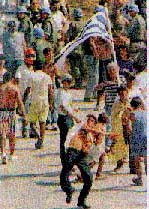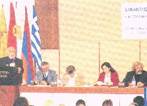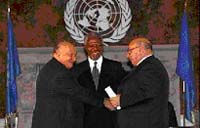History
early
history
1964-1974
after
1974
Articles
Rauf R. Denktash
Necati M. Ertekun
Fusun C. Doskaya
World Press
Documents
U.N. Resolutions
London-Zurich Treaties
Makarios' "13 points"
The Akritas Plan
FAQs
Guest Book
Search
|
|
Turkey
,
one of the guarantor states, called upon
Britain
,
as the other guarantor, for joint intervention, but the British politicians
declined to take action. On
20
July 1974
,
Turkey
intervened exercising its legitimate right granted to it under the article 4
of the Treaty of Guarantee of
16
August 1960
,
to end the problem in
Cyprus
.
On
25-30 July 1974, Foreign Ministers of Turkey,
Greece
and the
UK
,
held a conference on
Cyprus
in
Geneva
.
A declaration was signed at the end of the conference declaring, that ‘all
Turkish enclaves occupied by Greek or Greek Cypriot Forces should be
immediately evacuated’ and ‘a security zone should be set up’ between
the two zones. But Greek Cypriots continued their attacks on Turkish Cypriots
and the second Geneva Conference (9-13 August 1974) was unsuccessful. On 14
August 1974, Turkey held the second phase of “Peace Operation” as the
Turkish side calls it, and liberated Turkish Cypriots in the North and let
them live in peace. At the end of the second intervention, Turkish troops took
control of 38 % of the island. Many Greek Cypriots fled South, while many
Turkish Cypriots fled North. Since then the Southern part of the country has
been under the control of the Greek Cypriots and the Northern part has been
under the control of the Turkish Cypriots.
On
13
February 1975
,
the
Turkish
Federated
State
of
Cyprus
was proclaimed as the Turkish Cypriot wing of a future Federal Republic of
Cyprus. Also in the same year, during the Vienna Talks, under the auspices of
the UN Secretary General, both sides agreed on the voluntary moving of
populations. Greeks agreed to transfer Turks from South to North and the Turks
agreed to transfer Greeks form North to South.
Between
the years 1975 and 1983, attempts to solve the problem continued. On 12
February 1977, Denktash, the Turkish Cypriot leader, and Makarios, the Greek
Cypriot leader, agreed to settle the problem as two equal parties, on the
basis of a bi-zonal, bi-communal federal republic and ruled that
‘bi-zonality should not be watered down or destroyed under any plea or
excuse’ (Necatigil, 1996:154).
In
May 1983, U.N. General Assembly debated the
Cyprus
question and with the resolution (A/37/253) of
13
May 1983
,
demanded immediate withdrawal of all “occupation forces” and voluntary
return of refugees to their former homes. Turkish Cypriots described this
resolution as a “Death Warrant” and the intercommunal talks were
deadlocked. This resolution of the U.N. General Assembly resulted in the
proclamation of
Turkish
Republic
of Northern Cyprus (TRNC) on
15
November 1983
.
Two days after the proclamation, on
18
November 1983
,
the United Nations Security Council (Resolution 541) stated that the attempt
to create TRNC was “legally invalid” and asked all countries for
non-recognition. Since then, the TRNC has not been recognized by any state
except
Turkey
.
The
intercommunal negotiations resumed after the establishment of the TRNC. UN
Security Council continued adopting resolutions condemning “all secessionist
actions”, (550/
11
May 1984
)
as “illegal and invalid”. In August 1984, UN Secretary General presented
to the two communities his ideas described as “working points”, which
envisaged a bi-communal, bi-zonal federation, and both sides are asked to join
in “proximity talks”. As the result of three rounds of “proximity
talks” UN Secretary General submitted his document entitled “The Draft
Agreement on
Cyprus
”,
but the Greek Cypriots rejected it. Despite discouraging signals, the Turkish
Cypriots continued entering into informal talks with the UN Secretaritat to
achieve an overall agreement.
By
adopting its resolution 649, on
12
March 1990
,
UN Security Council made the situation on
Cyprus
clear. Firstly, this resolution agreed on the basis of the solution as a
bi-communal and bi-zonal federation, and stressed once more the importance of
the UN Secretary General’s mission of good offices. Secondly, it addressed
the two leaders in
Cyprus
as political equals, and called on them “to reach freely a mutually
acceptable solution providing for the establishment of a federation that will
be bi-communal as regards the constitutional aspects and bi-zonal as regards
the territorial aspects”. The Turkish side welcomed the resolution and said
that it was a long sought step in the right direction.
However
four months later, on
3
July 1990
,
the Greek Cypriots applied for full membership in the European Economic
Community (EC), the European Union of today (EU), and brought all efforts for
a negotiated settlement to the brink of total collapse. The Turkish Cypriots
opposed this move of the Greek Cypriots, by saying that the Greek Cypriot
Administration cannot represent
Cyprus
and is not entitled to apply for membership on behalf of
Cyprus
as a whole. For the Turkish Cypriots, this application considered as unlawful
and contrary to the Rule of Law.
During
the Gulf Crisis, which erupted one month later, the Greek Cypriots drew
parallelisms between
Iraq
’s
occupation of
Kuwait
and
Turkey
’s
intervention in
Cyprus
and demanded application of UN Resolutions on
Cyprus
.
U.S. Secretary of State and British Prime Minister of the time, stated that no
such linkages exist between the Gulf crisis and
Cyprus
,
and added that they are different events.
The
most important event of 1992 was the new UN Secretary General, Boutros-Boutros
Ghali’s new initiative, named the “set of ideas”, in which he said that
“the relationship of the two communities is that of two politically equal
communities and not that of a minority and majority”. The Turkish Cypriot
side affirmed that it agreed with 91 out of the 100 paragraphs. On the other
hand, the Greek Cypriot side stated that it accepted the “set of ideas” as
“a basis for reaching an overall framework agreement” but subject to
negotiation. They tried to look constructive but deadlocked the process.
The
situation did not change in 1994, when proximity talks on the implementation
of the Confidence Building Measures (CBMs) were held with the UN
representatives in
Cyprus
.
Whereas the Turkish Cypriot side expressed its readiness to conclude and sign
a CBM agreement, the Greek Cypriot side declared the package of CBMs and the
process as dead. The Greek Cypriots continued putting the EU membership of “
Cyprus
”
as a precondition for talks, and made it clear that they did not want to
discuss the CBMs until after a settlement. During 1995, the attempts of the
Turkish side, to implement the UN sponsored CBMs and to begin talks without
preconditions towards a viable bi-communal, bi-zonal Federal solution, failed.
Still,
under the auspices of the United Nations, efforts to reunite the island under
a federal structure continue.
history
main page |
|
Turkey
intervened exercising its legitimate right granted to it under the article 4
of the Treaty of Guarantee of
16
August 1960

A Greek Cypriot passed through the
UN troops trowing something to the Turkish Cypriots with Greece flag after
him...


The
Cyprus
talks between the Cypriot leaders, under the auspices of the United
Nations,
New
York.
|


